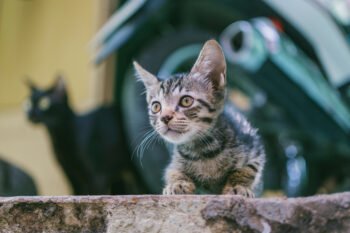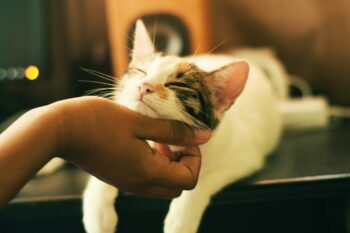A large, fluffy black cat grooms and protects a tiny three-legged kitten in Roxanne Ewing’s home, where she fosters felines for Pet Refuge, a no-kill shelter in Mishawaka, Indiana. Observing this intimate interaction, it appears as if a mother cat is attending to the needs of her kitten. The reality of this particular scene, however, is that the “mother” is a recently rescued (and neutered) male named Sammy and the kitten is an unrelated orphan female, Lana.
It seems an unlikely friendship — an odd couple of sorts. Feline behaviorists have long studied the intricate relationships between cats, and they are not sure what draws certain individuals to each other to form a special bond. In the case of Sammy and Lana, Ewing was surprised at this friendship, but Sammy seemed to know that Lana was “different” from the other cats and, for some reason, took on the role as protector/guardian.
Why do certain cats form friendships while others actually prefer to avoid other felines their entire lives? Domestic cats have always been recognized as “solitary” creatures — perhaps only in need of human companionship. But new research is changing that view.
Relatively Speaking
Littermates who grow up in a normal setting (being with their mother and siblings for the appropriate time period) often will remain close friends throughout their lives. The mother, however, will most likely try to rid herself of her babies (even if all have been spayed and neutered — including mom) to avoid inbreeding. The same may be true of siblings who do not get along — especially if they’re left intact. Hopefully, most owners are altering their felines and mating isn’t an issue. Generally, however, littermates who have been neutered will continue their bond into adulthood.
The Bonding Experience
The capacity for friendship and physical closeness in felines, however, surpasses kinship. Cats living in groups, such as shelter cats or a colony of feral cats, seem to become friends more readily than those in a home situation with only a few felines. These friendships are expressed in a variety of ways, including cuddling together, grooming each other, eating together, playing together and sleeping near one another.
Although males and females form the most common pairs, it’s not due to sexual attraction. Instead, it’s because cats of the opposite sex are less inclined to compete and fight over territory. In most instances, if you are a one-cat household, adding a second cat of the opposite sex (assuming they’re altered) seems to be the best bet. Territorial issues may still exist, but won’t be as strong as same-sex interactions.
Friendship Or Toleration
It’s virtually impossible to predict whether certain cats will become friends or, as in many cases, simply tolerate other felines sharing their space. Many factors, including the cats’ prior experience with other cats, the way they’re introduced, their temperaments and, of course, the owners’ responses to their interactions, affect whether they bond. Dominant cats are less likely to form friendships than submissive felines, unless the dominant cat takes the meek feline under his care — as in the case of the robust male, Sammy, and his fragile sidekick, Lana.
 Further research and observation are needed to help solve the mystery of feline friendships and what makes two cats become best friends. Perhaps we’ll never know for certain but, as in the case of humans, it seems finding someone to share your everyday life with is much better than spending it alone.
Further research and observation are needed to help solve the mystery of feline friendships and what makes two cats become best friends. Perhaps we’ll never know for certain but, as in the case of humans, it seems finding someone to share your everyday life with is much better than spending it alone.







